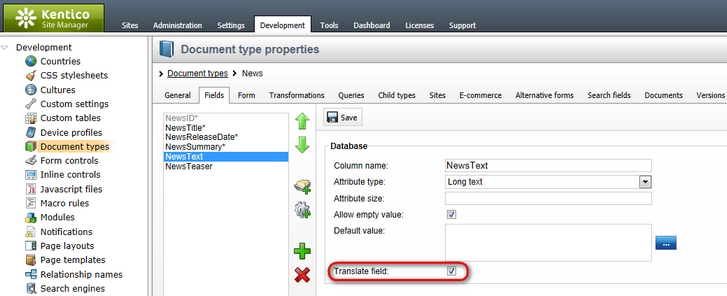Configuring content for translation |

|

|

|

|
|
Configuring content for translation |

|

|

|

|
|
|
||
Translation services can process the following types of document content:
•Content of editable regions
•Values of document fields (entered on the Form tab)
•The properties of web parts placed on the given document
•Document file attachments
The system allows you to specify exactly which parts of the content are translated. These settings affect all types of translation services.
To choose which document fields are sent for translation, adjust the form definition of individual document types:
1. Go to Site Manager -> Development -> Document types.
2. Edit (![]() ) a specific document type and open the Fields tab.
) a specific document type and open the Fields tab.
3. Select the field that you wish to configure and enable or disable the Translate field flag. Translation is only available for fields with the Text, Long text or File Attribute type.
4. Click ![]() Save to confirm the changes to the field.
Save to confirm the changes to the field.

Enabling the Translate field flag in the field editor
When users submit documents of the given type for translation, only the content of fields that have the Translate field flag enabled is included in the translation.
Pages may also contain text added via Web parts and Widgets. The only way to translate web part content is to localize the values of the corresponding web part properties. You can configure the system to automatically include specific web part properties in translations. This is only recommended for web parts that directly add text onto the page (such as Static text).
1. Go to Site Manager -> Settings -> Content -> Translation services and enable the Translate web part properties setting.
2. Open Site Manager -> Development -> UI cultures, select the All cultures tab, and add UI cultures for all content languages that you use on your website.
3. Navigate to Site Manager -> Development -> Web parts.
4. Select the appropriate web part and open the Properties tab.
5. Enable or disable the Translate field flag for individual properties. Translation is only available for properties that use the Text, Long text or File Attribute type.
6. Click ![]() Save for every modified property.
Save for every modified property.
If a document that contains the given web part is submitted for translation, the system includes the values of all properties that have the Translate field flag enabled. When importing the translation, the system creates a resource string for every translated property, containing the value in the target language. The original text values of the properties are replaced by localization macros, which insert the appropriate resource strings.
|
Editable text regions
Translation submissions always include the page content entered by users into Editable text web parts, regardless of the web part translation settings.
|
Human translation services allow users to submit file attachments for translation along with the main content of documents. To configure attachment translation for your website:
1. Go to Site Manager -> Settings -> Content -> Translation services.
2. Enable the Allow attachment translation setting.
3. Specify which types of files should be translated using the Translation attachments file types setting. Enter a list of all allowed file extensions separated by semicolons (for example: txt;docx;pdf). Leave the setting empty to allow translation for all types of attached files.
4. Click ![]() Save.
Save.
Users can check the Translate attached files option when submitting documents for translation, and the system adds all allowed file attachments into the translation source. When the completed translation is imported, the translated file is attached to the appropriate language version of the document.
|
File format
The system adds file attachments directly into the XLIFF translation source as binary data encoded in Base64 format.
|